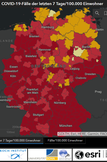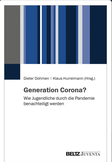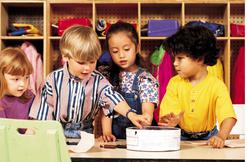The lockdown goes into overtime
Easter at Lockdown
(DE) Mr President, ladies and gentlemen, on Monday, the Chancellor and the Minister Presidents met once again and adopted what many - including myself - consider to be a strange document. I can certainly understand that some of the openings will have to be withdrawn. Or that others will not be implemented at all. The situation is serious - and perhaps even more serious than before (see: What is the current situation?).

What is the current situation?
As we had already feared at the end of February (), the number of confirmed infections with COVID 19 has continued to increase in recent weeks. While the 7-day incidence on 4 March, i.e. almost exactly three weeks ago, was on average 65 per 100,000 inhabitants in the last 7 days, it is now again almost 110 (data according to RKI - as of 23.3.2021 20.30h) - and the trend is clearly upwards. (It is explicitly pointed out that other websites sometimes give significantly higher values; the RKI is said to tend to have somewhat too low values according to this. See e.g. https://www.sueddeutsche.de/)
This increase is also reflected in the federal states, although there are still considerable fluctuations: currently, only Schleswig-Holstein and Saarland have slightly more than 60 new infections per 100,000 inhabitants in the last seven days. In contrast, Thuringia now has a value of over 200 again, Saxony of over 150 and Saxony-Anhalt of 126. The numbers are increasing exponentially, i.e. this week's increase of about 30% compared to the previous week is significantly stronger than last week's increase of about 20% compared to the previous week. In concrete numbers: if 100 persons per 100,000 were infected in the week before last, then it was 120 last week and 156 this week (130% times 120).
In addition, the so-called British mutation has spread rapidly and is now responsible for far more than half of the new infections. On the one hand, it is significantly more infectious than the previous variants, and on the other hand, it is significantly more dangerous, especially for younger people, children and adolescents. The course of the disease is on average longer and more severe.
What developments can be expected in the coming days and weeks?
The rising values can be observed despite the lockdown regulations still largely in place. For the coming week, a further intensifying rise is to be expected. That applies initially even if the tightenings decided on Monday are implemented in the coming week. The regulations decided on Monday 22.3. will apply from next week Monday, i.e. March 29. At the same time, it is likely that the British mutation will continue to increase in importance. The development of the past weeks has been exactly as predicted by the forecasts. The Robert Koch Institute expects an incidence of
It is therefore extremely important that we all contribute to preventing an increased rise in the number of infections as far as possible through cautious behaviour. At the same time, however, it is also important to keep the psychological burden as low as possible or not to increase it any further.
Does the British mutation increase the risk of infection for children and young people?
The British mutation is clearly more contagious than the previous variants, this also - and possibly especially - applies to children and adolescents. It may even be significantly more contagious in younger children, and the course of the disease seems to be less favourable. I.e. it often lasts longer and/or is more often associated with a more severe course.
In recent weeks, the corresponding values for children and adolescents have increased even more than for adults. Even if it is discussed whether other reasons, such as the more frequent testing, also have an influence on this, this is a disturbing development.
This means that the risk for children and adolescents to fall ill has increased. It is also true that then often to fall ill more seriously than before.
Are schools drivers of the pandemic?
A Robert Koch Institute study in late February stated, "In summary, the data presented and the studies cited above suggest that students tend not to play a major role as a "driver," but that incidence is closely related to incidence in the general population." In the following sentences, reference is made to the limited dispersion or prevalence outside of the immediate group of students. (https://www.rki.de/DE/Content/Infekt/EpidBull/Archiv/2021/Ausgaben/13_21.pdf?__blob=publicationFile). This means that, on average, schoolchildren get sick at about the same rate as the population as a whole. It should be noted that the average infection of the population is strongly influenced by the high risk of infection of the elderly. If this group were removed, the result would change. I am therefore not convinced by the RKI's conclusion.
Opening of day care centres
The first Länder already started to relax the emergency childcare regulations again a good month ago, i.e. on 22 February. In the last few weeks, a total of significantly more than half of the children were already back in the Kitas. This was because most countries had planned to return to normal operation. In some cases it was called "normal operation under pandemic conditions".
Since the decision of the Conference of Minister Presidents did not include any concrete regulations on how to proceed with the day-care centres, the Länder must decide how to proceed. Since the Easter holidays are coming up next week, it is possible that the daycare centers will have closing times and will be closed anyway. To find out whether this is the case at your child's daycare centre, please contact the daycare centre. The regulations that apply in the individual countries can be found on the CWDI page. We will post new regulations as soon as they are decided. As far as we know, there are no new regulations yet.
But it was decided on Monday that April 1, the Thursday before Easter (Maundy Thursday) should be a day of rest and all people should stay at home if possible. This would then also apply to the Kitas, if they are not closed anyway.
Opening of schools
The first Länder already started to open schools again more strongly for face-to-face teaching a good month ago, i.e. on 22 February. In the last few weeks, therefore, most pupils have already been back in school - albeit mostly in so-called alternating lessons with smaller classes - the concrete implementation (e.g. daily or weekly alternation) is mostly up to the schools. Among experts, this is considered a comparatively good solution, as the risk of infection is significantly reduced - but it is of course still present.
Some of the Länder have continued to suspend compulsory attendance in class. This means that children do not have to go to school, they can also stay at home. In many cases, however, this could mean that they get nothing or little of the lessons, as teachers cannot be in front of the class and engaged in distance learning at the same time. Even though this is often expected.
Since the decision of the Conference of Minister Presidents did not include any concrete regulations on how to proceed with the schools, the Länder must decide how to proceed here. However, as the Easter holidays are coming up next week, it is obvious that the regulations that have been in force so far will continue to apply for the time being and then a decision will be made in the next few days or during the Easter holidays on how to proceed.
The regulations in force in the individual countries can be found on the CWDI page.
We post new regulations whenever they are adopted. To our knowledge, there are no new regulations as yet.
How do children and young people cope with the situation?
After many children and adolescents seemed to have come through the Corona pandemic comparatively well for quite some time, the reports about increasing stress in large parts of the children and adolescents are accumulating. Today, the Bertelsmann Foundation reports that two thirds of young people say they are psychologically burdened, lonely or fearful of the future. We will deal with this in a separate article in the next few days.
Parents between the chairs: Should the children go to daycare or school?
For most parents, the question of whether or not to use the open daycare centres and schools will continue to arise in the coming days. The decision is difficult, because very different aspects have to be weighed up.
On the one hand, there is health protection and the goal of keeping the risk of infection as low as possible. In any case, the risk is higher when the children go to daycare or school. They meet more children in the group or class. And they are often travelling by bus or train. This increases the risk of infection, even if the children put on the mask. This higher risk is likely to have been a major factor in the significant rise in numbers in recent weeks. Although other influencing factors, such as more frequent testing, may have played a role.
On the other hand, it is about the participation in educational and learning processes and also about the reduction of psychological stress among children, young people and/or parents. Many children and young people feel very strongly burdened by the lockdown, closed daycare centres and schools. They also have little contact with friends, etc. You as parents should take this into account in any case, which you probably do anyway.
Most parents are extremely stressed by the double and triple burden, and the problems in balancing family and work, the permanent squatting on top of each other etc.. These reasons speak in favour of children and young people going back to daycare or face-to-face teaching at school.
Parents should discuss the question of whether the children go to daycare or school together with the children and bring about a joint decision. This is an important step towards taking children seriously and integrating them into family structures as equals. You should also discuss the decision with the children and take them seriously if they want to go to school and you don't think that's a good idea. Or if they want to stay at home even though you are absolutely stressed and at your limit. Please also remember that the British version is much more contagious, especially for children (see above).
Since the decision will probably be made most of the time for the children to go to daycare or school, I would like to suggest a few precautions to keep the risk of infection low:
Take the children to school and, if possible, do not let them travel by bus or train. Even if this is not exactly ecological and means effort for you. If possible, share the task with other parents in your area.
If you can influence the organization of the alternating lessons, vote for the (two-) daily alternation. This means that the children go to school every other day. This reduces the frequency of how often the children have to go to school. It also means they are on the bus and train less on the way to or from school. And it also reduces the burden on you to get the kids to school.
It also has the advantage that contact with the school is maintained and the children can study at home for the day when they are not at school, provided with learning materials and assignments. Many teachers report that the children usually cope very well with this.
Use the rapid tests provided - have the children tested twice a week if possible. And do this yourself if necessary, if the children are possibly only tested once or not at all. Also insist on regular testing at daycare centers or schools. Even if these tests only provide security for the moment, if it is negative, it also means that you can be relatively sure that there is no one in the daycare group or class who is already infected.
Discuss with the nursery or class management how it can be ensured that the frequency of contact is as low as possible. Is it possible that - if possible - it is always the same teacher who teaches your children? In the nursery, the group sizes should be limited and mixing of the groups should be avoided as far as possible.
In addition, it would be good if the children see a limited group of children regularly. This prevents loneliness and reduces the risk that children are psychologically stressed. Rather than parents, limit yourself to give children the opportunity to see and stay in touch with friends.
Other arrangements and contacts outside school, sports, etc
The most important decisions concern the Easter days: Here it is aimed that as far as possible all people keep their contacts as low as possible for five days. For this purpose, two so-called days of rest will be introduced: On the Thursday before Easter, which is April 1 (Maundy Thursday), all people are to stay at home, and offices and shops are to be completely closed. Whether this will be a public holiday - and therefore also work-free - is still unclear. On Saturday, only grocery stores are to be open, with everything else closed. Travel is also to be reduced to the bare minimum over Easter.
You are allowed to meet with people from a second household, as long as you are no more than five people. Children up to the age of 14 are not counted. Couples who are not living together count as one household.
In addition, the other regulations in force since 3 March continue to apply. However, the regulations depend on the infection situation on site:
If the incidence rate is less than 50 new infections per 100,000 persons in the last 7 days:
Then up to five people from two households can meet. Children up to 14 years are not counted.
Then, starting next week, up to 10 people will be allowed to play sports together outside, as long as it is a sport where there is no physical contact. That means: running together, playing tennis is allowed - football, basketball etc. not (with so many people at the same time). With children, as I understand it, there are no restrictions, i.e. they would also have to be allowed to play ball in larger groups, for example.
If the incidence rate is less than 50 new infections per 100,000 persons in the last 7 days:
Starting next week, up to 10 people will be allowed to play sports together outside, as long as it is a sport that does not involve physical contact.
Individual sports with a maximum of five people from two households and sports in groups of up to 20 children up to 14 years of age are permitted, provided that they take place outdoors.
If the incidence rate is greater than 100 new infections per 100,000 persons in the past 7 days:
In this case, the "old" rules apply again. That means: meeting with a maximum of one other person from another household, no sports in groups, no matter if jogging or playing ball etc..
According to my understanding in this case also Kitas and schools would have to go then actually again into the Lockdown, however there are to my knowledge in addition no agreements, also not of the conference of education ministers.
Published on
Topics
Articles on the topic
-
How do I find a school place for my child?
Depending on the state and type of school, different things need to be...

-
Childcare - how does it work in Germany?
The path from application to daycare place is simple and complicated at...

-
Controversy: open schools or close schools?
Politicians should react now to slide unprepared into a forced closure....

-
Corona pandemic severely disadvantages children and young people - but there is no "Corona generation"
This is a core finding of the anthology "Generation Corona? How young...

-
What to do after the Easter holidays? - Part 2: Final exams
An overview of the regulatory diversity

-
Kitas and schools in a state of flux
Update from 9.4.2021 on the current regulations
